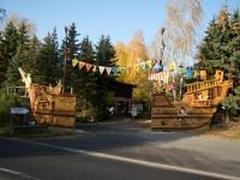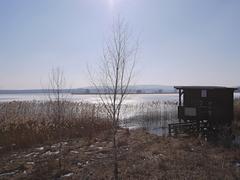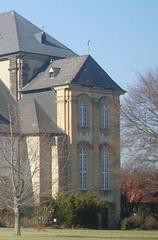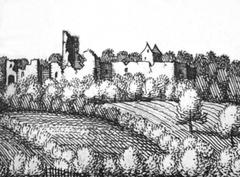
Comprehensive Guide to Visiting Dillsgraben, Heere, Germany
Date: 18/08/2024
Introduction
Nestled in the picturesque Harplage range near Königsdahlum in the Hildesheim district of Lower Saxony, Germany, Dillsgraben is a fascinating natural monument that seamlessly blends geological wonder, ecological diversity, and historical intrigue. The site, spanning approximately 1.8 hectares, was designated as a natural monument in 1996, but its formation dates back around 1,000 years through a unique geological process known as subrosion. This process involves the dissolution of soluble rocks like gypsum by groundwater, leading to the collapse of overlying rock layers and the creation of a sinkhole. Dillsgraben is more than just a geological marvel; it is an ecological haven, a subject of local folklore, and a site of significant historical interest. Visitors are drawn to its steeply sloping walls, semi-natural deciduous forests, and the dynamic lake at the bottom of the sinkhole, which supports a unique ecosystem. This guide aims to provide comprehensive information on visiting Dillsgraben, including its historical background, geological importance, visitor information, and nearby attractions, offering a holistic view of this remarkable destination. Whether you are a nature enthusiast, history buff, or casual tourist, Dillsgraben promises an enriching experience that highlights the natural beauty and historical depth of the region.
Table of Contents
- Introduction
- Historical Background
- Significance of Dillsgraben
- Visitor Information
- Nearby Attractions
- Conservation Efforts
- FAQ
- Conclusion
- Additional Resources
Historical Background
Formation and Geological Significance
Dillsgraben is a notable geological formation that spans approximately 1.8 hectares and was designated as a natural monument in 1996 due to its unique geological characteristics and historical significance. Estimated to be around 1,000 years old, the Dillsgraben formed through a process known as subrosion, involving the dissolution of soluble rocks like gypsum by groundwater, leading to the collapse of overlying rock layers and the creation of a sinkhole.
Geographical Context
Located on the northeastern slope of the Harplage ridge, Dillsgraben is approximately 1.3 kilometers northwest of the village church of Königsdahlum. It is flanked by the Hachumer Bach to the north and another stream to the south, both flowing into the Nette River to the east. The surrounding landscape is characterized by natural deciduous forests, contributing to the area’s ecological diversity and scenic beauty.
Historical Development
Dillsgraben has been a subject of local folklore and historical interest for centuries. The legend of the Dillsburg, a castle-like villa built in 1888 by Johann Friedrich Weule, the founder of the tower clock factory and bell foundry J.F. Weule, adds to its intrigue. Although there are no concrete historical records to support the existence of an ancient castle mentioned in the folklore, the site continues to captivate visitors with its rich history and natural beauty.
Significance of Dillsgraben
Geological Importance
Dillsgraben is a notable geological feature characterized by a sinkhole formed by the subrosion (leaching) of soluble underground rocks, a classic example of karst topography. The dissolution of gypsum rocks in the Middle Muschelkalk layer has led to the collapse of the overlying Trochitic limestone cover rocks, creating a naturally formed funnel with a diameter of approximately 140 meters and steeply sloping walls about 30 meters high.
Ecological Significance
This geological marvel is also an ecological haven. The sinkhole’s flanks are covered with semi-natural deciduous forests, providing a habitat for various flora and fauna. The lake at the bottom of the sinkhole, which is about 60 meters deep, experiences periodic fluctuations in water level due to changes in the groundwater level. This dynamic environment supports a unique ecosystem that is crucial for local biodiversity.
Historical and Cultural Relevance
Designated as a natural monument since 1996, Dillsgraben holds significant local and scientific importance. The nearby Dillsburg, a castle-like villa built around 1888 by Johann Friedrich Weule, adds historical intrigue to the site. Although privately owned, the villa enriches the cultural landscape of the area.
Scientific Research and Education
Dillsgraben serves as an excellent site for scientific research and education. Its unique geological formation provides valuable insights into karst processes and groundwater dynamics. Researchers and students from various fields, including geology, hydrology, and ecology, utilize the site to study these natural processes.
Visitor Information
Tickets and Visiting Hours
Dillsgraben is accessible to the public without an entrance fee. However, guided tours and special events might have associated costs. The site is open year-round, but the best visiting hours are during daylight to fully appreciate the natural beauty and historical significance.
Travel Tips and Accessibility
Located about 1.3 kilometers northwest of the village church in Königsdahlum, Dillsgraben can be reached via well-marked hiking trails. Comfortable hiking shoes and water are recommended, especially during summer. The best times to visit are in spring and autumn when the weather is mild, and the surrounding forests are most vibrant.
Special Events and Guided Tours
Various guided tours and educational programs are available to enhance public awareness and appreciation of Dillsgraben. These tours provide in-depth knowledge about the geological processes, ecological significance, and conservation efforts of the site.
Nearby Attractions
Bodenstein Cliff Plateau
Another hiking highlight, the Bodenstein cliff plateau, features stunning rock formations and panoramic views. The area is ideal for peaceful forest walks, spotting flora and fauna, and even rock climbing for adventure seekers.
The Pyramid Mausoleum
The nearby pyramid mausoleum inters Count Ernst zu Münster and his family in sarcophagi. This architectural marvel adds a historical and cultural dimension to your visit with its unique pyramid shape.
Schloss Derneburg
Once owned by the Münster family, Schloss Derneburg has been transformed into a cultural hub hosting art exhibitions and events. Touring the castle provides insights into the region’s aristocratic past and contemporary cultural significance.
Conservation Efforts
As a protected natural monument, Dillsgraben is subject to various conservation efforts aimed at preserving its unique features. These efforts include monitoring the site, managing surrounding vegetation, and conducting scientific studies to understand the impact of natural and human activities.
FAQ
-
What are the visiting hours for Dillsgraben?
- Dillsgraben is open year-round, but it’s best visited during daylight hours.
-
Is there an entrance fee for Dillsgraben?
- No, there is no entrance fee, but guided tours and special events might have associated costs.
-
How do I get to Dillsgraben?
- The site is about 1.3 kilometers northwest of the village church in Königsdahlum and can be reached via well-marked hiking trails.
Conclusion
Dillsgraben in Heere, Germany, epitomizes a blend of natural beauty, historical significance, and cultural richness. This natural sinkhole, formed by the unique geological process of subrosion, offers visitors a remarkable glimpse into the dynamic and ever-changing nature of our planet. Its ecological diversity, supported by semi-natural deciduous forests and a fluctuating lake, makes it a haven for flora and fauna, while its historical connections, including the nearby Dillsburg villa, add layers of cultural intrigue. Accessible year-round and free of charge, Dillsgraben is a welcoming destination for all. Whether you are drawn by its geological formations, hiking opportunities, or the surrounding historical sites like Bodenstein Cliff Plateau, the Pyramid Mausoleum, and Schloss Derneburg, Dillsgraben offers a memorable and enriching experience. Conservation efforts ensure that this protected natural monument continues to be a valuable site for scientific research, education, and public appreciation. Plan your visit to Dillsgraben today to explore its unique geological features, rich biodiversity, and historical depth, and don’t forget to stay updated with the latest information by downloading the Audiala mobile app or following relevant social media channels.






